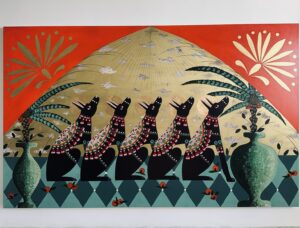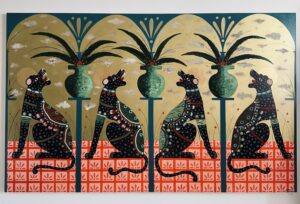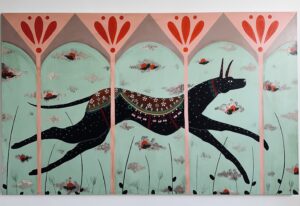At Casa del Cinema, in conjunction with Taormina Arte (music, prose and dance festival), the personal exhibition of Alessandro Florio, born in 1979, was inaugurated on 8 July. The artist’s surname inevitably evokes the spices and splendor of the well-known and historic Florio family and of the western Sicilian coast. Instead, this artist lives on the east coast, where his exhibition is underway: “Finestra a Sud”, which can be visited until August 31, and is curated by the Taormina Arte Sicilia Foundation. Already in the choice of this title, linked to the particular futuristic window of his laboratory, the geographical indication of a warm sunny latitude of the South resounds which can also become space/time for the soul. In fact, Florio declares that «painting is equivalent to breathing, or rather making the soul breathe».

Alessandro Florio, Paloma Negra, 260 x 160 cm, acrylic and gold leaf on canvas, 2023, courtesy of the artist
His works show colored scenarios, dreamlike animals on a two-dimensional space without perspective. And the artist, who particularly loves the painting of Giotto and Cimabue, declared that he has “an attraction towards the sacred, the divine dogma”, referring to that golden bond which would connect his pictorial vision to sacred art. In line with his way of feeling the sacred theme, his color strokes emerge from the often golden backgrounds of his canvases. In this show there are on display ten large canvases and five papier-mâché donkeys.

Alessandro Florio, Apparizione ai santi, 260 x 160 cm, acrylic and gold leaf on canvas, 2023, courtesy of the artist
The exhibition hall is intimate and welcoming, and at the entrance a sequence of Persian carpets mark and adorn the arrangement of the works with references to bizarre decorations and arabesque colonnades. These works could almost be considered “contemporary vertical carpets” and seeing them corresponds to a visual journey towards warm African colors and towards that symbolic rhythm, typical of Arab compositions because Florio thus underlines his southern origins, and his belonging to a land that it was also dominated by the Arabs for a long time and from these it brings back the lively and always dynamic sensuality of their ornamental motifs.

Alessandro Florio, Chiostro San Domenico, 260 x 160 cm, acrylic and gold leaf on canvas, 2023, courtesy of the artist
Florio, in his personal need to assemble, associate and make pictorial objects interact in a harmonious, symmetrical and visionary sense, intends to bind himself to sacred art, reinterpreting the two-dimensional pictorial plane where the absence of the third dimension is a conscious choice to make his painting light, suspended, harmonic for nostalgic dreamers of starry skies and shooting stars from a thousand and one nights. The sacred for him is the very breath of painting and those golden backgrounds, which would link him to the gold of Byzantine icons, become another symbol of sacredness for his imaginative landscapes, which celebrate the imagination beyond reality in a world where fantasy is often associated only with the world of childhood.

Alessandro Florio, Cirneco, 260 x 160 cm, acrylic and gold leaf on canvas, 2023, courtesy of the artist
The papier-mâché donkey heads stand out: silent, hung in series in the corridor that overlooks the exhibition hall. These heads emerge from the wall of the exhibition space with great eloquence while being taciturn. After all, the donkey is an animal that characterized Sicily in the past when these beasts carried heavy goods. And there is yet another link with Arab culture because it would seem that the dialectal term “u sceccu” derives from the word “sheikh” for an Arab legend linked to Sicilian history. Thus, Florio has chosen an animal, almost animic, to be delivered to the gaze of his audience to redeem the idea one has of the donkey – considered less fascinating than a horse – to make it decorated, colorful because his painting is a light flight perhaps on a flying donkey, but in the footsteps of a visionary and imaginative sacredness.
Info:

Through art she feels the need to get closer to nature, deciding to create an artistic residence on Etna as a “refuge for contemporary art” for artists and scholars. Thus was born Nake artistic residence. She won the Responsible Etna Award 2015. In 2017, she was invited to the Sala Zuccari, Senate of the Republic, as an art critic. She writes for Italian and foreign artists. Curator of the first Museum of Contemporary Art of Etna and of the “Contemporary Etna” project.






NO COMMENT